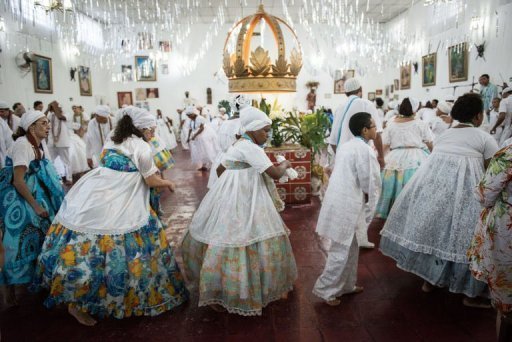Each follower is paired with a specific orisha, who is connected to a force in nature and worshipped with offerings of foods. Those aspiring to be priests must go through lengthy initiation rites that last at least seven years.
Best known orishas are Olorun (Supreme Being), his son Oxala assimilated to Jesus Christ, Shango (god of fire, thunder and justice), Ogun (warrior deity of metal work), Oxossi (hunter deity of the forest), Oshun (goddess of love, marriage and maternity) and Iemanja (the goddess of the sea and patron deity of fishermen).
Until the 1970s, the faith was officially banned and thus practiced in secret. Even today, many followers are reluctant to publicly admit that they are adherents.
For that reason, it is difficult to accurately size up the country’s Candomble community. Some estimates put it at two million members, but the real figure is likely to be considerably higher.
And today, Candomble, also practiced in neighboring countries, is enjoying a revival as an affirmation of African identity and pride, particularly in the northeastern state of Bahia state, the heart of Afro-Brazilian culture.
Official persecution of Candomble was part of a bid to eradicate African influence and led to the emergence of Umbanda in 1908, said Mae Sylvia.
— Umbanda: broader appeal among whites —
Umbanda incorporates not only the cult of the orishas, but also elements of Catholicism, indigenous beliefs and the European spiritist movement developed by Frenchman Allan Kardec in the 19th century.
Because it is less Africa-centered and excludes animal sacrifice, it has a much broader appeal among white Brazilians.
Rubens Saraceni, a white Brazilian medium, is a prominent Umbanda priest and writer.
“Candomble keeps a very strong heritage from Africa, while Umbanda gives equal weight to indigenous beliefs, spiritism and Christianity,” he explained during a festival honoring the deity Ogun in April.
Nearly 1,000 disciples, most of them whites, attended the Ogun festival, chanting, dancing and breaking into trance during spirit possession.
Saraceni estimates that with 600,000 Umbanda centers operating nationwide, the faith has at least eight million declared followers and keeps growing every year.

